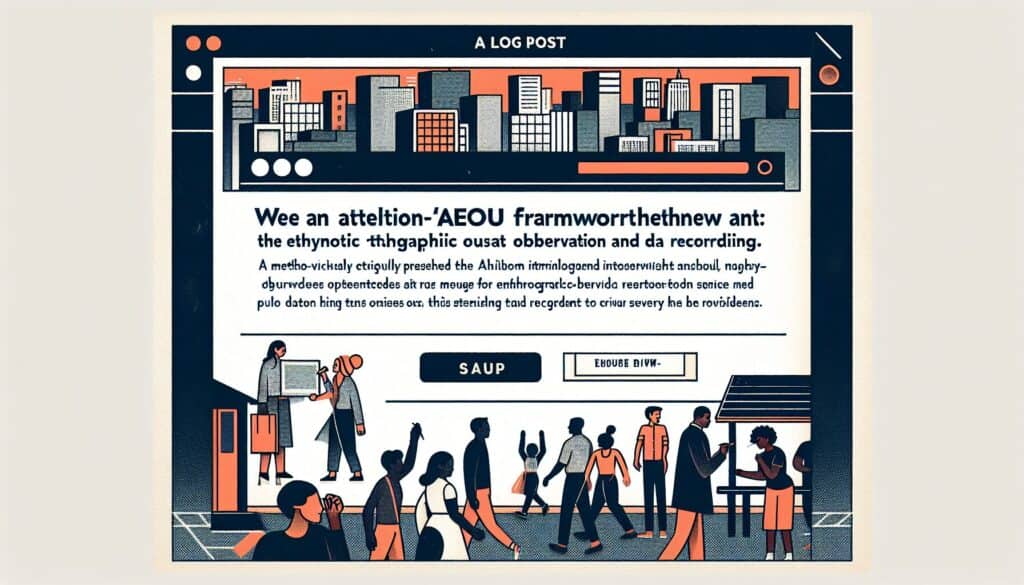Guider l'observation ethnographique et la collecte de données en fournissant un cadre structuré. cadre pour catégoriser les détails environnementaux et comportementaux.
- Méthodologies : Clients et marketing, Économie, Conception de Produits
Cadre AEIOU

Cadre AEIOU
- Cartographie de l'itinéraire du client, Pensée conceptuelle, Conception centrée sur l'humain, Conception d'interaction, Expérience utilisateur (UX), User-Centered Design
Objectif :
Comment il est utilisé :
- Les observateurs documentent les activités (actions orientées vers un but), les environnements (le contexte dans lequel se déroulent les activités), les interactions (entre les personnes, les objets ou l'environnement), les objets (éléments clés de l'environnement) et les utilisateurs (les personnes observées, leurs rôles et leurs comportements).
Avantages
- Fournit une structure complète mais simple pour les observations sur le terrain, permet de s'assurer que tous les aspects clés sont pris en compte, facilite la collecte et l'analyse systématiques des données, utile pour découvrir les besoins latents des utilisateurs.
Inconvénients
- La documentation complète peut prendre beaucoup de temps, un biais de l'observateur est possible, une grande quantité de données qualitatives peut être générée, ce qui nécessite un effort d'analyse important, l'efficacité dépend des compétences de l'observateur.
Catégories :
- Clients et marketing, Ergonomie, Idéation, Conception de Produits
Idéal pour :
- Mener des recherches sur les utilisateurs et des études ethnographiques afin d'acquérir une connaissance approfondie des comportements et des besoins des utilisateurs, ainsi que du contexte dans lequel les produits ou les services seront utilisés.
Le cadre AEIOU est une méthodologie polyvalente applicable à divers secteurs, notamment l'électronique grand public, la conception des soins de santé et l'urbanisme. Il est particulièrement efficace dans les premières phases de développement d'un produit, où la compréhension des interactions des utilisateurs et des conditions environnementales peut éclairer les décisions de conception. Les chercheurs sur les utilisateurs, les concepteurs d'interaction et les ethnographes sont généralement à l'origine de cette approche, car elle nécessite un engagement direct avec les publics cibles afin d'observer et de documenter leurs comportements dans des contextes réels. En pratique, les équipes peuvent mener des études sur le terrain dans des environnements tels que des maisons, des hôpitaux ou des lieux de travail, ce qui leur permet de capturer un large éventail d'activités d'utilisateurs tout en prenant note des environnements environnants et des interactions qui s'y déroulent. Par exemple, dans l'industrie automobile, l'observation des conducteurs dans leur véhicule et la prise en compte de la manière dont ils interagissent avec les commandes et consacrent du temps à diverses tâches peuvent permettre d'améliorer la conception afin d'accroître la sécurité et le confort des utilisateurs. La nature structurée du cadre AEIOU garantit que toutes les dimensions de l'expérience de l'utilisateur sont méthodiquement enregistrées, ce qui permet une analyse complète des données et l'identification des besoins non satisfaits de l'utilisateur, conduisant en fin de compte à une conception plus pertinente et plus efficace de l'expérience de l'utilisateur. centré sur l'utilisateur des solutions de produits. Cette méthodologie permet non seulement de mettre en lumière les nuances du comportement des utilisateurs, mais aussi de saisir le contexte dans lequel les produits seront utilisés, ce qui peut s'avérer déterminant lors du développement de nouvelles fonctionnalités ou de nouveaux services qui répondent aux attentes des utilisateurs. Les collaborations entre équipes pluridisciplinaires, y compris les ingénieurs et les spécialistes du marketing, peuvent s'appuyer sur les conclusions du cadre AEIOU pour aligner le développement de produits sur les désirs réels des utilisateurs, favorisant ainsi des innovations qui sont non seulement réalisables mais aussi souhaitables sur les marchés ciblés.
Principales étapes de cette méthodologie
- Observer les activités des utilisateurs dans leur environnement naturel.
- Documenter les objectifs associés aux actions des utilisateurs.
- Noter les interactions entre les utilisateurs et leur environnement.
- Identifier et enregistrer les objets significatifs présents dans l'environnement.
- Caractériser les utilisateurs, en notant leurs rôles et leurs comportements.
- Analyser les observations recueillies pour en dégager des schémas et des thèmes.
Conseils de pro
- Incorporez le retour d'information direct des utilisateurs dans vos méthodes d'observation afin de valider les hypothèses et de garantir l'alignement sur les attentes des utilisateurs.
- Utiliser des outils de cartographie visuelle pour représenter les composantes de l'AEIOU, afin de faciliter la compréhension des relations et du contexte au cours de l'analyse.
- Engagez les utilisateurs dans des scénarios de jeux de rôle pour capturer les réactions en temps réel et les réponses émotionnelles dans divers environnements.
Lire et comparer plusieurs méthodologies, nous recommandons le
> Référentiel méthodologique étendu <
ainsi que plus de 400 autres méthodologies.
Vos commentaires sur cette méthodologie ou des informations supplémentaires sont les bienvenus sur le site web de la Commission européenne. section des commentaires ci-dessous ↓ , ainsi que toute idée ou lien en rapport avec l'ingénierie.
Contexte historique
1986
(si la date est inconnue ou n'est pas pertinente, par exemple "mécanique des fluides", une estimation arrondie de son émergence notable est fournie)

Articles Similaires
Calculateur de METS en calories
Méta-analyse
Cartographie des messages
Diagrammes du modèle mental
Forces de poussée et de traction maximales acceptables
Planification des besoins en matériaux (MRP)